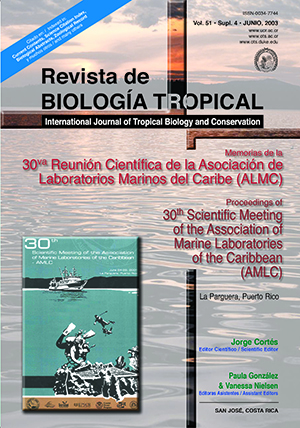Resumen
Ostreopsis lenticularis Fukuyo 1981, es un dinoflagelado bentónico y el principal vector implicado en envenenamientos por ciguatera en peces arrecifales en la costa sur-oeste de Puerto Rico. Cultivos clonales de O. lenticularis (clón 301) que fueron expuestos en el laboratorio a temperaturas elevadas (30-31°C) por 33 y 54 días demostraron aumentos signi-ficativos en la cantidad de toxinas extraíbles que produjeron al comparar su toxicidad con la de cultivos que crecieron a temperaturas de 25-26°C. Muestras de O. lenticularis recogi-das directamente del campo después de estar expuestas a temperaturas elevadas demostraron aumentos significativos en la cantidad de toxi-nas extraíbles. El aumento en toxicidad evi-dente en las muestras de campo, al igual que en las muestras del laboratorio expuestas a altas temperaturas puede ser el resultado de los efectos de las altas temperaturas actuado sobre el metabolismo o los simbiontes bacterianos asociados a estas microalgas. El número de bacterias asociadas con los cultivos de O. lenticularis expuestos a altas temperaturas se vieron significativamente reducidos. El au-mento en la cantidad de toxinas recuperadas de O. lenticularis expuestos a altas temperatu-ras pudieron resultar del efecto directo de la temperatura sobre la producción de toxinas o a la reducción en la flora bacteriana asociada a Ostreopsis.Citas
Ballantine, D.L., T.R. Tosteson & A. Bardales. 1988. Population dynamics and toxicity of natural popula-tions of benthic dinoflagellates in southwestern Puerto Rico. J. Exp. Mar. Biol. Ecol. 119: 201-212.
Faust, M.A., S.L. Morton & J.P. Quod. 1996. Further SEM study of marine dinoflagellates: the genus Ostreopsis (Dinophyceae). J. Phycol. 32: 1053-1065.
Gonzalez, I., C. Tosteson, V. Hensley & T. Tosteson. 1995. Associated bacteria and toxicity development in cultured Ostreopsis lenticularis, p. 451-456. In P. Lassus, G. Arzul, E. Erard, P. Gentien & C. Marcaillou (eds). Harmful Marine Algal Blooms. Proceedings of the Sixth International Conference on Toxic Marine Phytoplankton. Lavoisier, Paris, France.
Hallegraeff, G.M., M.A. McCausland & R.K. Brown. 1995. Early warning of toxic dinoflagellate blooms of Gymnodinium catenatum in southern Tasmanian waters. J. Plankton Res. 17: 1163-1176.
Krieg, N.R. & J.G. Holt (eds.). 1984. Bergey’s Manual of Systematic Bacteriology, Vol. 1. Williams & Wilkins, Baltimore. 836 p.
Lewis, N., S. Bates, J. McLachlan & J. Smith. 1993. Tem-perature effects on growth, domoic acid production, and morphology of the diatom Nitzschia pungens f. multiseries, p. 601-606. In T. Smayda & Y. Shimizu (eds). Toxic Phytoplankton Blooms in the Sea. Elsevier, New York.
Morton, S.L., D.R. Norris & J.W. Bomber. 1992. Effect of temperature, salinity and light intensity on the growth and seasonality of toxic dinoflagellates associated with Ciguatera. J. Exp. Mar. Biol. Ecol. 157: 79-90.
Ogata, T., T. Ishimaru & M. Kodama. 1987. Effect of water temperature and light intensity on growth rate and toxicity change in Protogonyaulax tamarensis. Mar. Biol. 95: 217-220.
Oshima, Y., H. Itakura, K.C. Lee, T. Yasumoto, S. Blackburn & G. Hallegraff. 1993. Toxin production by the dinoflagellate Gymnodinium catenatum, p. 907-912. In T. Smayda & Y. Shimizu (eds). Toxic Phytoplankton Blooms in the Sea. Elsevier, New York.
Stein, J.R. 1973. Handbook of Phycological Methods. Culture methods and growth measurements. Cambridge University, New York. 395 p.
Tosteson, T.R., D.L. Ballantine, C.G. Tosteson, A.T. Bardales, H.D. Hurst & T.B.Higerd. 1986. Compara-tive toxicity of Gambierdiscus toxicus, Ostreopsis cf.lenticularis and associated microbial flora. Mar. Fish. Rev. 48: 57-59.
Tosteson, T.R., D.L. Ballantine, C.G. Tosteson, V. Hensley & A.T. Bardales. 1989. Associated bacterial flora, growth, and toxicity of cultured benthic dinoflagellates Ostreopsis lenticularis and Gambierdiscus toxicus. Appl. Environ. Microbiol. 55: 137-141.
Tosteson, T.R., R.A. Edward & D.C. Baden. 1992. Carib-bean and polyether dinoflagellate toxins: Correlation of barracuda Ciguatoxins with standard toxins, p. 89-102. In T.R.Tosteson (ed.). Proceedings of the Third International Conference on Ciguatera Fish Poison-ing. Polyscience, Quebec, Canada.
Tosteson, T.R. 1995. The diversity and origins of toxins in Ciguatera fish poisoning. Puerto Rico Health Sciences Journal (PRHSJ) 12: 117-129.
Tosteson, T., D. Ballantine & A. Winter. 1998. Sea sur-face temperature, benthic dinoflagellate toxicity and toxin transmission in the Ciguatera food web, p. 48-49. In B. Reguera, J. Blanco, Ma L. Fernandez & E. Wyatt (eds.). Proc. 8th Inter. Conf. Harmful Algae. Xunta de Galicia and UNESCO.
Weil, C.S. 1952. Tables for the convenient calculation of Median-Effective Dose (LD50 and ED50) and instruc-tions in their use. Biometrics 8: 249-263.
##plugins.facebook.comentarios##

Esta obra está bajo una licencia internacional Creative Commons Atribución 4.0.
Derechos de autor 2003 Revista de Biología Tropical


